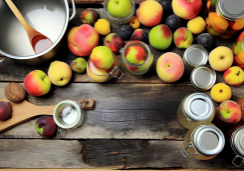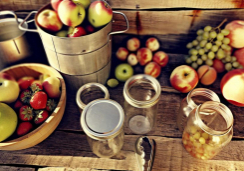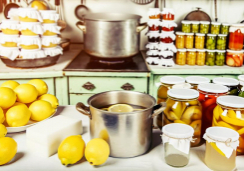8 Best Techniques for Perfect Pizza Dough
Nearly 83% of Americans eat pizza at least once a month, showcasing the dish's unwavering popularity. As you're likely part of this statistic, it's essential to recognize that the foundation of any great pizza starts with the dough. You've probably had your share of lackluster crusts, either too dense or disappointingly soggy, and you know the disappointment it brings to an otherwise delightful experience.
But don't worry; perfecting pizza dough is within your grasp. You'll find that mastering a few key techniques can transform your homemade pizzas into culinary masterpieces that rival your favorite pizzeria. From selecting the ideal flour to understanding the nuances of fermentation, each step is critical.
Stay with me, and I'll share eight tried-and-true techniques that will elevate your pizza game to new heights, allowing you to craft a dough that's not only reliable but also boasts that coveted, delectable crispness with every bite.
Selecting the Right Flour
When crafting your perfect pizza dough, selecting a high-quality flour tailored to your taste and texture preferences is essential.
For a refined crust with a silky-smooth and stretchable dough, double zero flour, also known as '00 flour,' is the secret ingredient. This Italian favorite is finely milled and offers a high hydration capacity. It is responsible for the light and airy texture of authentic Neapolitan pizza crusts.
On the other hand, if you prefer a heartier bite, you might lean towards using bread flour. With its higher protein content, it gives your pizza dough a chewier texture that can hold up well to a generous assortment of toppings.
If you're looking for a versatile middle ground, all-purpose flour can also yield a delightful crust. It offers a balance of ease of handling and a pleasant crunch.
Hydration and Dough Consistency
Mastering the art of hydration is key to transforming your pizza dough into a light, crispy canvas for your favorite toppings. When making pizza dough, striking the right balance between water and flour defines your dough's destiny. Imagine biting into that perfect pizza slice, its crust a harmonious blend of crunch and chewiness—this dream begins with hydration and dough consistency.
As you experiment with pizza dough recipes, you'll find that hydration levels can vary. The goal is to achieve a dough that's slightly tacky to the touch, yet doesn't stick to your hands or the counter. Room temperature water often works best, allowing the yeast to activate more efficiently. This is where the dough ball becomes your telltale heart. When you stretch the dough, it should be pliable and resilient, a testament to your mastery over hydration.
Yeast Proofing and Fermentation
As you warm the water to the sweet spot between 110 and 115 degrees Fahrenheit, you're setting the stage for the yeast to spring into action, ensuring your dough will rise into a light, airy foundation for your toppings.
The fermentation period not only allows the dough to develop the perfect texture but also enriches it with a depth of flavor that'll make your pizza irresistible.
Keep an eye out for the telltale signs of a well-risen dough – it's all about timing and those delicate, frothy bubbles that promise a sublime crust.
Optimal Yeast Activation Temperature
To achieve the perfect rise in your pizza dough, make sure to activate your yeast at the sweet spot of 110 to 115 degrees Fahrenheit, ensuring those tiny organisms spring to life and work their bubbly magic. Here's how you can get there:
- Measuring Temperature:
- Use a thermometer for precision.
- Aim for the optimal range to activate yeast.
The first step in your pizza dough recipe is crucial: if the water's too hot, the yeast will perish; too cold, and it won't wake up. Let the dough sit at room temperature after mixing to allow a slow, flavorful fermentation. When you're ready to make pizza, your home oven will welcome a beautifully risen dough, thanks to your attention to temperature.
Fermentation Duration and Flavor
Having perfected the temperature for yeast activation, it's equally important to consider the length and conditions of fermentation to enhance the flavor of your pizza dough.
Letting your dough sit for at least two hours at a comfortable room temperature, between 60-70 degrees Fahrenheit, allows for a fermentation duration that's just right to coax out a depth of flavor akin to a sourdough starter.
As the dough slowly ferments, air bubbles form, creating the light, airy texture that'll make your homemade pizza taste better.
By ensuring your water is within the ideal temperature range for yeast proofing, you're setting the stage for a perfect rise.
Dough Rise: Signs & Timing
You'll know your pizza dough is ready for the oven when it has puffed up to twice its original size, becoming a light, airy mass that springs back gently upon touch.
Here's how you can master the signs and timing of dough rise:
- Signs of Proper Fermentation:
- Your ball of dough should feel light and airy.
- A gentle poke should leave a slight indentation that slowly disappears.
- Timing Your Proofing:
- Keep the dough covered with plastic wrap at room temperature.
- It typically takes 1-2 hours for the dough to double, but don't rush it; yeast works on its own schedule.
Kneading for Gluten Development
Kneading the dough is key to unlocking the chewy, elastic texture that's essential for the perfect pizza crust. When you're diving into home baking, mastering this step in your pizza dough recipes is crucial for gluten development. Gluten, the protein network within your flour, gives the dough its structure and elasticity. By using a folding and pressing motion, you're aligning these gluten strands, creating the foundation for a crust that's both sturdy and delightfully pliable.
Imagine the satisfaction as you push and fold the dough on a floured surface, feeling it transform under your hands. After about 10-15 minutes of this rhythmic kneading, you'll notice the dough becoming increasingly smooth and bouncy. It's ready when it springs back promptly after being poked.
If you're using a stand mixer, the kneading technique is even more effortless. The dough hook does the work for you, mimicking the traditional hand-kneading method. Whether by hand or machine, these techniques ensure that your pizza dough will have the perfect balance of strength and stretch, promising a mouthwatering pizza experience right from your own kitchen.
Shaping the Dough Correctly
Achieving the perfect pizza begins with shaping your dough into a smooth, round ball, setting the stage for a crust that's both crispy and chewy. Once you've got your ball of dough, it's time for the delicate art of shaping the dough correctly:
- Flatten and stretch the dough with your hands to get that ideal thickness. Here's how to do it right:
- Start from the center and work your way outwards, leaving the edges slightly thicker to form a pillowy crust.
- Rotate the dough as you stretch it to maintain an even shape.
Transfer your shaped dough onto a pizza peel dusted with flour. This will make it easier for you to slide your creation onto the hot pizza stone waiting in the oven. Remember:
- Keep the pizza dough at room temperature to ensure it's pliable.
- Don't overload with toppings; a balanced pizza is a beautiful pizza.
Avoid the temptation to use a rolling pin, as it can deflate the dough and hinder the development of those lovely air pockets that contribute to a crunchy crust. Instead, let your hands coax the dough, enjoying the tactile experience of pizza making.
With practice, your dough will transform into a base worthy of the most delicious toppings and memorable baking moments.
Temperature and Rising Environment
Now that you've shaped your pizza dough, it's crucial to find the sweet spot for rising: a cozy 60-70 degrees Fahrenheit.
In this ideal warmth, your dough will puff up, creating the perfect foundation for a light, airy crust that's simply irresistible.
Optimal Dough Temperature
To ensure your pizza dough rises perfectly, maintain its temperature between 60-70 degrees Fahrenheit in a draft-free environment. When making pizza dough at home, this optimal temperature range is crucial for achieving that airy, chewy texture synonymous with the best York-Style Pizza. Here's what to keep in mind:
- Use a thermometer to check the water:
- Ideal for yeast activation: 110-115°F
- Adjust for seasons:
- Summer: cooler water
- Winter: warmer water
Baking your pizza on a preheated baking stone in an oven cranked to high heat ensures a crisp crust that's the hallmark of a great pie. Remember, room temperature plays a role in rising, so always be mindful of your kitchen's climate. Practice makes perfect, so don't be afraid to experiment!
Ideal Rising Conditions
Understanding the optimal dough temperature is just the foundation; creating the ideal rising conditions is the key to ensuring your pizza dough puffs up to its full, delectable potential. To achieve great pizza, you'll need to let your dough sit for at least 2 hours in a draft-free spot where the temperature is a cozy 60-70 degrees Fahrenheit. This precise warmth is like a gentle hug, encouraging your dough to rise perfectly.
Most recipes will call for a doubling in size—this is a sign of readiness. When you're making pizza, always use a baking environment that's free from drafts to prevent the surface from drying out. And remember, whether you're using pizza ovens or a conventional kitchen setup, the consistency in checking the dough's progress is 100% necessary for that ideal rise.
Preparing for the Oven
Before sliding your pizza dough into the heat, crank up your home oven to its maximum, typically 550 degrees Fahrenheit, ensuring it's fiercely hot for that perfect crust. A searing oven will give you that delectable, pizzeria-quality char on your dough, so don't be shy—get that oven as hot as you can.
Here's what to do next:
- Use a pizza peel:
- Dust with flour to prevent sticking.
- Transfer your pizza effortlessly into the oven.
- Prep your tools:
- *Baking stone*: Mimics a brick oven's floor, absorbing moisture for a crispy base.
- *Cast iron skillet*: For a deep-dish delight, with edges that crisp up beautifully.
Once your oven is hot, brush your dough with a thin layer of olive oil for a golden touch. Spread your favorite pizza sauce, but don't overload it; you want the flavors to meld, not to make your base soggy.
Baking Techniques and Equipment
Mastering the art of baking the perfect pizza begins with harnessing the power of your home oven, using a pizza stone or baking steel to ensure even heat distribution for that irresistibly crispy crust. When following recipes that call for the highest temperatures, preheat your oven to 550 degrees F, or as high as it will go. This is one of the essential tips for making good pizza that rivals your favorite pizzeria.
If the recipe calls for a deep-dish style, consider a cast iron skillet. It's a game-changer for achieving that delectable, crispy bottom crust that everyone craves. And don't worry about the dough sticking; parchment paper is your ally. It allows you to easily slide your creation onto the baking surface without using too much flour, which can toughen the crust.
You also need to make sure that you're going to use the right baking techniques and equipment. Make perfect use of your kitchen tools by experimenting with unconventional ingredients like beer in your dough, which can add a unique flavor and assist in the leavening process.
Frequently Asked Questions
What Is the Trick to Good Pizza Dough?
The trick lies in balancing dough hydration, choosing the right flour, kneading properly, allowing enough fermentation time, ensuring active yeast, controlling temperature, stretching the dough gently, and perfecting the proofing process for optimal gluten development.
What Techniques Do You Use When Making Pizza Dough?
When making your pizza dough, carefully choose your flour, mind the water temp, and knead thoroughly. Let it rest to develop gluten, proof your yeast well, balance the salt, add oil, and ferment properly.
How Can I Make My Pizza Dough Better?
To enhance your pizza dough, focus on hydration level and flour type; knead thoroughly, allow a proper resting period; use fresh yeast, correct water temperature; and don't forget timely salt addition, oil incorporation, and sugar content.
What Is the Key to Pizza Dough?
The key lies in mastering flour selection, water temperature, and kneading duration to optimize gluten development, dough elasticity, and yeast freshness. Balance salt, perfect fermentation, and add oil for the ultimate pizza dough.
Conclusion
Now you've mastered the art of pizza dough perfection! With top-tier flour, balanced hydration, and precise yeast action, your dough's foundation is unshakable.
Your expert kneading and shaping techniques have set the stage. The perfect rise in a cozy spot has ensured a light, airy texture.
All that's left is to slide your masterpiece into a blazing oven. Anticipate the irresistible aroma and the first bite of that dreamy, crisp crust.
Buon appetito, pizza maestro!










